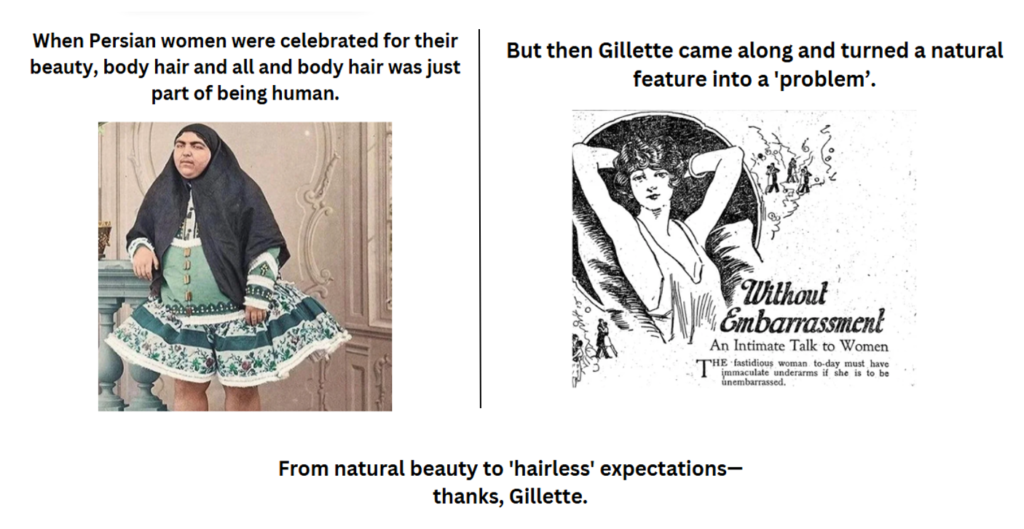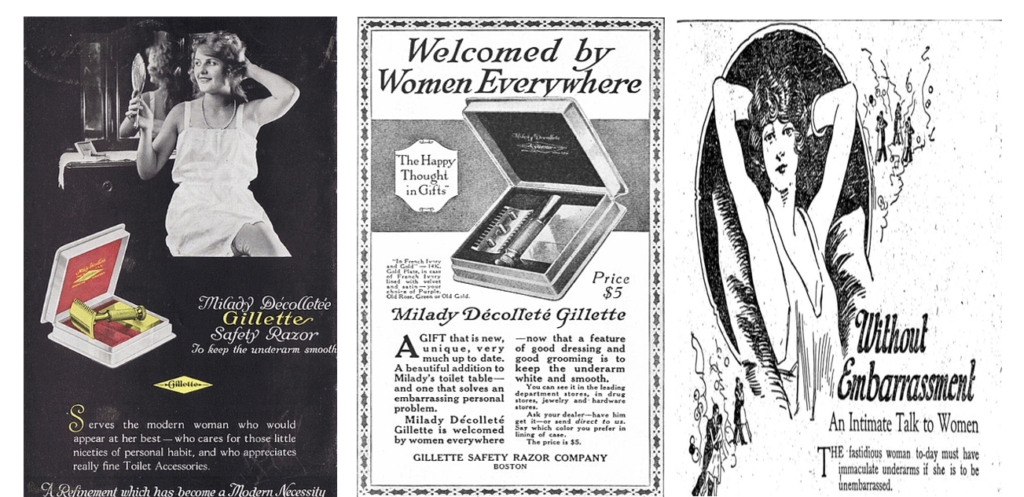Do you ever stop and think about why women are expected to shave their legs, while men can rock a little stubble without anyone blinking an eye? Spoiler alert: It’s not a natural law—it’s all about capitalism! If you don’t believe us, let’s take a deep dive into Gillette’s history. This American brand for razors, shaving supplies, and personal care products has not only revolutionized the shaving world but has also played a major role in shaping how we think about beauty standards. Ready for a ride? Buckle up!

💡Gillette is owned by one of the largest multi-national corporation in the FMCG space – Procter & Gamble (P&G).
Gillette: From Wild Idea to Shaving Giant
So, who’s behind that razor you use? It all started back in the early 1900s with a guy named King C. Gillette. Now, before you think of some medieval king in a crown, hold on! King C. Gillette had a crazy idea—what if men never had to sharpen their razors again? Instead of dull, worn-out blades, they could just toss them away and grab a fresh one! Sounds like magic, right? Well, it wasn’t at first. It took Gillette six years to figure out how to make cheap, sharp blades. And guess what? In 1903, they sold 51 razors and 168 blades. But by the next year? BOOM—90,000 razors and 12.4 million blades sold. Talk about a “close shave” with failure!
Then came World War I. The U.S. military gave out Gillette razors to soldiers, and just like that, shaving became a daily ritual instead of a luxury. Gillette became the name in razors. And they haven’t looked back since!
The Razor-and-Blades Model: Gillette’s Secret Sauce for Success
Here’s the thing—Gillette didn’t just sell razors. They sold the idea of convenience. The razor-and-blades business model was pure genius: sell the razor handle for a cheap price, but charge a pretty penny for the replacement blades. And guess what? People kept coming back for more. This setup ensured steady revenue from customers who had to keep buying blades regularly. Genius, right?
But here’s the twist: the model works, but it can feel a little… coercive. If you buy a razor handle at a low price, you may end up feeling like you have to keep buying those expensive replacement blades. Ouch!
How Gillette Introduced Women to Shaving and the Potential Pink Tax

Here’s where it gets interesting: in 1915, Gillette introduced the world to its first razor made specifically for women—the Milady Décolletée. This wasn’t just about shaving; it was about creating a new beauty standard. Before Gillette’s marketing magic, women weren’t expected to shave their legs or underarms. It wasn’t a thing. But soon, Gillette’s clever ads convinced women that smooth, hairless skin was a must to be considered “beautiful” or “hygienic.”
Talk about turning a perfectly natural thing (body hair) into a problem that needed a solution! And just like that, Gillette helped create a whole new industry that sold razors as “the fix.” But here’s where things get a little shady: when Gillette marketed these razors to women, they often used pretty colors like pink and added a touch of extra design. But here’s the kicker—the same razors, marketed for women, were priced higher than those for men. Enter the Potential Pink Tax.
The Potential Pink Tax refers to the extra amount that women pay for products like razors, even though they work just the same as men’s products. In other words, women’s razors were marketed with pretty colors, and BAM—prices went up, even though the function was exactly the same. This sparked a huge debate: why should women’s razors cost more than men’s? It’s just hair removal, right?
The Potential Pink Tax: What’s Gillette’s Role?
So, what’s the deal with the potential Pink Tax? Well, despite all the shaving tech, there’s still the question of whether Gillette is charging women more simply because of the color and design of the razors. While the brand’s continuous innovation is impressive, it’s essential to address whether women should pay more for essentially the same thing.
Gillette’s pricing structure may raise eyebrows, but let’s not forget—innovations in shaving products have made the process smoother (pun intended). But the brand must also think about whether its pricing is fair across the board. After all, beauty standards should not come at an extra cost, right?
Gillette’s Shaving Innovations: From Safety Razors to 5-Blade Systems
Over the years, Gillette didn’t just sit back and relax. Oh no. They kept innovating. In 1901, they introduced the safety razor. Then in 1915, they launched the Milady Décolletée, which was designed just for women. In the 1970s, the Super-Speed razor was born, offering a faster shave. By the 2000s, Gillette was like, “Why stop at two blades? Let’s go for five!” They launched the Fusion razor with five blades, and it became a hit.
But what really made them stand out in recent years was the introduction of the SkinGuard razor in 2018—designed for sensitive skin and to minimize irritation. No more razor burns!
Cracking the Indian Market: Gillette’s Bold Move in Rural India
Gillette’s approach to the Indian market has been a mix of innovation and strategic insight. Known for packing its razors with impressive features like multiple blades, precision trimmers, and lubricating strips, Gillette continues to dominate the market. While trends in shaving styles may shift, Gillette India ensures it stays relevant. One key strategy has been tapping into the image of the disciplined, clean-shaven soldier – a figure many men look up to. Through clever campaigns and razor innovations, Gillette solidified its position in urban India, where it enjoys near-monopoly status.
However, the real challenge now lies in rural India. Gillette must make its premium razors appealing to the price-sensitive rural market. The key is offering affordable, quality products while retaining the aspirational appeal of the brand for urban consumers. By using targeted messaging, strategic distribution, and a deep understanding of local needs, Gillette aims to expand into these untapped areas, maintaining its dominant position across India.
Conclusion
In conclusion, Gillette’s innovative strategies have undoubtedly set it apart in the shaving industry, showcasing its potential to continuously evolve and lead the market. However, the brand’s pricing structure raises concerns about the potential existence of the potential “pink tax”—where women’s grooming products are priced higher than their male counterparts. While Gillette’s technological advancements are impressive, the brand must also address these societal concerns and ensure its products and pricing reflect a commitment to fairness and inclusivity.
Subscribe to our blog to stay updated on the latest marketing strategies, industry trends, and expert insights to fuel your business growth! 🚀 Have any topics in mind? Drop a comment below and let us know what you’d love to see next!
Best Digital Marketing Campaign: Oreo’s Winning Strategy
Did the words “Twist, Lick and Dunk” ring a bell? You guessed it right! We’re…
group3.digitalmarketing1@gmail.com
Vanshika is a high-achieving student who is currently in her second year of the Integrated Program in Management (IPM) at IIM Jammu. Presently, Vanshika interns at Bharat Heavy Electricals Limited (BHEL), and earlier interned with Hindustan Unilever Limited (HUL) where she got substantial experience in project management. Before that, she honed her skills in digital marketing as an E-commerce and SEO Intern with Women Entrepreneurs India. She participates actively within the IIM Jammu community as a Student Coordinator for Anandam, Centre of Happiness and Toastmasters Club. The outstanding talent possessed by this young lady was acknowledged when she received the Reliance Foundation Undergraduate Scholar award.
